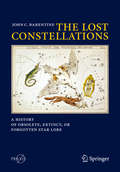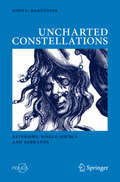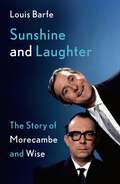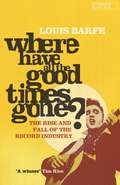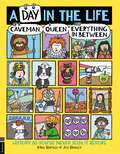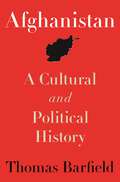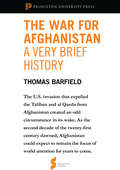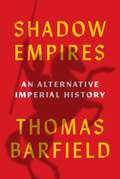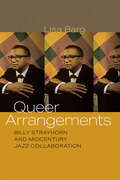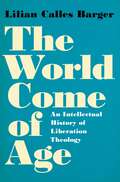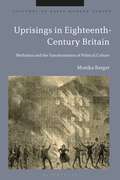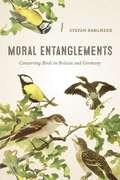- Table View
- List View
The Lost Constellations: A History of Obsolete, Extinct, or Forgotten Star Lore (Springer Praxis Books)
by John C. BarentineCasual stargazers are familiar with many classical figures and asterisms composed of bright stars (e.g., Orion and the Plough), but this book reveals not just the constellations of today but those of yesteryear. The history of the human identification of constellations among the stars is explored through the stories of some influential celestial cartographers whose works determined whether new inventions survived. The history of how the modern set of 88 constellations was defined by the professional astronomy community is recounted, explaining how the constellations described in the book became permanently “extinct.” Dr. Barentine addresses why some figures were tried and discarded, and also directs observers to how those figures can still be picked out on a clear night if one knows where to look. These lost constellations are described in great detail using historical references, enabling observers to rediscover them on their own surveys of the sky. Treatment of the obsolete constellations as extant features of the night sky adds a new dimension to stargazing that merges history with the accessibility and immediacy of the night sky.
Mystery of the Ashen Light of Venus: Investigating a 400-Year-Old Phenomenon (Astronomers' Universe)
by John C. BarentineThe “Ashen Light” of Venus—a ghostly emission of light from the night side of our nearest planetary neighbor—is among the last unsolved mysteries of astronomical history. In the four centuries since the phenomenon was first reported, highly reputable visual observers of Venus have recorded seeing the Ashen Light, while others have spent a lifetime searching for it without once being convinced that they ever saw it. Is the Ashen Light a trick of the eye? The result of a defective lens? A real scientific event? Occasional references to the Ashen Light are scattered across the literature, yet no work to date has synthesized these records. This book therefore digs deep into the history of the mystery and our latest attempts to understand it, sifting through the clues that might explain whether it is caused by physics, is conjured up by the eye or brain, or a combination of both. This baffling story will appeal to amateur astronomers, hobbyists, and lay readers interested in joining the debate about one of the most elusive observable phenomena ever recorded in the night sky.
Uncharted Constellations: Asterisms, Single-Source and Rebrands (Springer Praxis Books)
by John C. BarentineThis book compiles an array of interesting constellations that fell by the wayside before the IAU established the modern canon of constellations. That decision left out lesser known ones whose history is nevertheless interesting, but at last author John Barentine is giving them their due. This book is a companion to "The Lost Constellations", highlighting the more obscure configurations. The 16 constellations found in this volume fall into one or more of three broad categories: asterims, such as the Big Dipper in Ursa Major; single-sourced constellations introduced on surviving charts by a cartographer perhaps currying the favor of sponsors; and re-brands, new figures meant to displace existing constellations, often for an ideological reason. All of them reveal something unique about the development of humanity's map of the sky.
Sunshine and Laughter: The Story of Morecambe & Wise
by Louis BarfeThe unique story of Eric Morecambe and Ernie Wise – British television's most iconic double act. 'A warm and sympathetic portrait of two pals who conquered the world simply by radiating hilarious friendship' Sunday Times 'Barfe lifts the lid on the lives of TV's most iconic double act... and gets to the heart of what made them so loved by a nation' Sunday Post 'Set to be the definitive account of the television age's funniest pair' New European 'Colour about the characters of [Morecambe and Wise] is mixed with Barfe's usual forensic research' ChortleThe Morecambe and Wise Show was the crème de la crème of TV light entertainment from the late 1960s until the early 1980s. The hardy perennial comedy duo at its heart had even greater longevity, spanning five decades and becoming a national institution whose shows drew audiences in excess of twenty million. They also loved each other like brothers, and the audience repaid that love; they were the nation's best friends.In Sunshine and Laughter, Louis Barfe tells the touching story of Morecambe and Wise, and explores how it is that thirty-seven years after their last television show, the tall handsome one with glasses and the one with the short, fat, hairy legs continue to work their unique brand of comedy magic.
Turned Out Nice Again: The Story of British Light Entertainment
by Louis BarfeWith a cast of thousands, including Peter Cook, Ken Dodd, Dusty Springfield, Spike Milligan, Rolf Harris, Bruce Forsyth and Reeves and Mortimer, Turned Out Nice Again reveals a world of comedians and cavorters, dancing girls and crooners. From the early days of vaudeville, via the golden age of radio, to live television spectaculars, the rise of the chat show and alternative comedy, Louis Barfe pulls back the curtain of variety to reveal the world of light entertainment in all its glory.
Where Have All the Good Times Gone?: The Rise And Fall Of The Record Industry
by Louis BarfeLouis Barfe's elegantly written, authoritative and highly entertaining history charts the meteoric rise and slow decline of the popular recording industry. Barfe shows how the 1920s and 1930s saw the departure of Edison from the phonograph business he created and the birth of EMI and CBS. In the years after the war, these companies, and the buccaneers, hucksters, impresarios and con-men who ran them, reaped stupendous commercial benefits with the arrival of Elvis Presley, who changed popular music (and sales of popular music) overnight. After Presley came the Beatles, when the recording industry became global and record sales reached all time highs. Where Have All The Good Times Gone? also charts the decline from that high-point a generation ago. The 1990s ushered in a period of profound crisis and uncertainty in the industry, encapsulated in one word: Napster. Barfe shows how the almost infinite amounts of free music available online have traumatic and disastrous consequences for an industry that has become cautious and undynamic.
A Day in the Life of a Caveman, a Queen and Everything In Between
by Mike Barfield Jess BradleyShortlisted for the Lollies 2023__________________________A colourful and comical tour through history from cartoonists Mike Barfield and Jess Bradley.The hilarious minds behind A Day in the Life of a Poo, a Gnu and You have teamed up once again – this time to give a taste of the daily lives of the people, animals and objects who made history.Featuring a day in the life of early humans as they paint mammoths on the walls of a cave, a fierce gladiator battling in the Colosseum and the first woman in space. And not forgetting the animals of history – from an Egyptian cat (worshipped as a god, of course) to an albatross flying over Rapa Nui and a dog in the trenches of the First World War.Readers can also discover the stories behind famous constructions, including the Great Wall of China and Shakespeare’s Globe Theatre, and delve into the secret diaries of a Viking, Isaac Newton’s cat and the wooden panel that became the Mona Lisa.With over 90 entries told in the friendly, informative style of Mike Barfield and brought to life by Jess Bradley’s brilliantly funny illustrations, this book will have children learning and laughing as they go.
Afghanistan: A Cultural and Political History
by Thomas BarfieldAfghanistan traces the historic struggles and the changing nature of political authority in this volatile region of the world, from the Mughal Empire in the sixteenth century to the Taliban resurgence today. Thomas Barfield introduces readers to the bewildering diversity of tribal and ethnic groups in Afghanistan, explaining what unites them as Afghans despite the regional, cultural, and political differences that divide them. He shows how governing these peoples was relatively easy when power was concentrated in a small dynastic elite, but how this delicate political order broke down in the nineteenth and twentieth centuries when Afghanistan's rulers mobilized rural militias to expel first the British and later the Soviets. Armed insurgency proved remarkably successful against the foreign occupiers, but it also undermined the Afghan government's authority and rendered the country ever more difficult to govern as time passed. Barfield vividly describes how Afghanistan's armed factions plunged the country into a civil war, giving rise to clerical rule by the Taliban and Afghanistan's isolation from the world. He examines why the American invasion in the wake of September 11 toppled the Taliban so quickly, and how this easy victory lulled the United States into falsely believing that a viable state could be built just as easily. Afghanistan is essential reading for anyone who wants to understand how a land conquered and ruled by foreign dynasties for more than a thousand years became the "graveyard of empires" for the British and Soviets, and what the United States must do to avoid a similar fate.
Afghanistan: A Cultural and Political History (PDF)
by Thomas BarfieldAfghanistan traces the historic struggles and the changing nature of political authority in this volatile region of the world, from the Mughal Empire in the sixteenth century to the Taliban resurgence today. Thomas Barfield introduces readers to the bewildering diversity of tribal and ethnic groups in Afghanistan, explaining what unites them as Afghans despite the regional, cultural, and political differences that divide them. He shows how governing these peoples was relatively easy when power was concentrated in a small dynastic elite, but how this delicate political order broke down in the nineteenth and twentieth centuries when Afghanistan's rulers mobilized rural militias to expel first the British and later the Soviets. Armed insurgency proved remarkably successful against the foreign occupiers, but it also undermined the Afghan government's authority and rendered the country ever more difficult to govern as time passed. Barfield vividly describes how Afghanistan's armed factions plunged the country into a civil war, giving rise to clerical rule by the Taliban and Afghanistan's isolation from the world. He examines why the American invasion in the wake of September 11 toppled the Taliban so quickly, and how this easy victory lulled the United States into falsely believing that a viable state could be built just as easily. Afghanistan is essential reading for anyone who wants to understand how a land conquered and ruled by foreign dynasties for more than a thousand years became the "graveyard of empires" for the British and Soviets, and what the United States must do to avoid a similar fate.
Afghanistan: A Cultural and Political History, Second Edition
by Thomas BarfieldA major history of Afghanistan and its changing political cultureAfghanistan traces the historic struggles and the changing nature of political authority in this volatile region of the world, from the Mughal Empire in the sixteenth century to the Taliban resurgence today. Thomas Barfield introduces readers to the bewildering diversity of tribal and ethnic groups in Afghanistan, explaining what unites them as Afghans despite the regional, cultural, and political differences that divide them. He shows how governing these peoples was relatively easy when power was concentrated in a small dynastic elite, but how this delicate political order broke down in the nineteenth and twentieth centuries when Afghanistan's rulers mobilized rural militias to expel first the British and later the Soviets. Armed insurgency proved remarkably successful against the foreign occupiers, but it also undermined the Afghan government's authority and rendered the country ever more difficult to govern as time passed. Barfield vividly describes how Afghanistan's armed factions plunged the country into a civil war, giving rise to clerical rule by the Taliban and Afghanistan's isolation from the world. He examines why the American invasion in the wake of September 11 toppled the Taliban so quickly, and how this easy victory lulled the United States into falsely believing that a viable state could be built just as easily.Afghanistan is essential reading for anyone who wants to understand how a land conquered and ruled by foreign dynasties for more than a thousand years became the "graveyard of empires" for the British and Soviets, and why the United States failed to avoid the same fate.
Afghanistan: A Cultural and Political History, Second Edition (Princeton Shorts Ser. #9)
by Thomas BarfieldA major history of Afghanistan and its changing political cultureAfghanistan traces the historic struggles and the changing nature of political authority in this volatile region of the world, from the Mughal Empire in the sixteenth century to the Taliban resurgence today. Thomas Barfield introduces readers to the bewildering diversity of tribal and ethnic groups in Afghanistan, explaining what unites them as Afghans despite the regional, cultural, and political differences that divide them. He shows how governing these peoples was relatively easy when power was concentrated in a small dynastic elite, but how this delicate political order broke down in the nineteenth and twentieth centuries when Afghanistan's rulers mobilized rural militias to expel first the British and later the Soviets. Armed insurgency proved remarkably successful against the foreign occupiers, but it also undermined the Afghan government's authority and rendered the country ever more difficult to govern as time passed. Barfield vividly describes how Afghanistan's armed factions plunged the country into a civil war, giving rise to clerical rule by the Taliban and Afghanistan's isolation from the world. He examines why the American invasion in the wake of September 11 toppled the Taliban so quickly, and how this easy victory lulled the United States into falsely believing that a viable state could be built just as easily.Afghanistan is essential reading for anyone who wants to understand how a land conquered and ruled by foreign dynasties for more than a thousand years became the "graveyard of empires" for the British and Soviets, and why the United States failed to avoid the same fate.
The War for Afghanistan: A Cultural and Political History"
by Thomas BarfieldWhen it invaded Afghanistan in 2001, the United States sought to do something previous foreign powers had never attempted: to create an Afghani state where none existed. More than a decade on, the new regime in Kabul remains plagued by illegitimacy and ineffectiveness. What happened? As Thomas Barfield shows, the history of previous efforts to build governments in Afghanistan does much to explain the difficulties besetting this newest experiment. Princeton Shorts are brief selections taken from influential Princeton University Press books and produced exclusively in ebook format. Providing unmatched insight into important contemporary issues or timeless passages from classic works of the past, Princeton Shorts enable you to be an instant expert in a world where information is everywhere but quality is at a premium.
The War for Afghanistan: A Cultural and Political History"
by Thomas BarfieldWhen it invaded Afghanistan in 2001, the United States sought to do something previous foreign powers had never attempted: to create an Afghani state where none existed. More than a decade on, the new regime in Kabul remains plagued by illegitimacy and ineffectiveness. What happened? As Thomas Barfield shows, the history of previous efforts to build governments in Afghanistan does much to explain the difficulties besetting this newest experiment. Princeton Shorts are brief selections taken from influential Princeton University Press books and produced exclusively in ebook format. Providing unmatched insight into important contemporary issues or timeless passages from classic works of the past, Princeton Shorts enable you to be an instant expert in a world where information is everywhere but quality is at a premium.
Shadow Empires: An Alternative Imperial History
by Thomas J. BarfieldAn original study of empire creation and its consequences, from ancient through early modern timesThe world’s first great empires established by the ancient Persians, Chinese, and Romans are well known, but not the empires that emerged on their margins in response to them over the course of 2,500 years. These counterempires or shadow empires, which changed the course of history, include the imperial nomad confederacies that arose in Mongolia and extorted resources from China rather than attempting to conquer it, as well as maritime empires such as ancient Athens that controlled trade without seeking territorial hegemony. In Shadow Empires, Thomas Barfield identifies seven kinds of counterempire and explores their rise, politics, economics, and longevity.What all these counterempires had in common was their interactions with existing empires that created the conditions for their development. When highly successful, these counterempires left the shadows to become the world’s largest empires—for example, those of the medieval Muslim Arabs and of the Mongol heirs of Chinggis Khan. Three former shadow empires—Manchu Qing China, Tsarist Russia, and British India—made this transformation in the late eighteenth century and came to rule most of Eurasia. However, the DNA of their origins endured in their unique ruling strategies. Indeed, world powers still use these strategies today, long after their roots in shadow empires have been forgotten.Looking afresh at the histories of important types of empires that are often ignored, Shadow Empires provides an original account of empire formation from the ancient world to the early modern period.
Shadow Empires: An Alternative Imperial History
by Thomas J. BarfieldAn original study of empire creation and its consequences, from ancient through early modern timesThe world’s first great empires established by the ancient Persians, Chinese, and Romans are well known, but not the empires that emerged on their margins in response to them over the course of 2,500 years. These counterempires or shadow empires, which changed the course of history, include the imperial nomad confederacies that arose in Mongolia and extorted resources from China rather than attempting to conquer it, as well as maritime empires such as ancient Athens that controlled trade without seeking territorial hegemony. In Shadow Empires, Thomas Barfield identifies seven kinds of counterempire and explores their rise, politics, economics, and longevity.What all these counterempires had in common was their interactions with existing empires that created the conditions for their development. When highly successful, these counterempires left the shadows to become the world’s largest empires—for example, those of the medieval Muslim Arabs and of the Mongol heirs of Chinggis Khan. Three former shadow empires—Manchu Qing China, Tsarist Russia, and British India—made this transformation in the late eighteenth century and came to rule most of Eurasia. However, the DNA of their origins endured in their unique ruling strategies. Indeed, world powers still use these strategies today, long after their roots in shadow empires have been forgotten.Looking afresh at the histories of important types of empires that are often ignored, Shadow Empires provides an original account of empire formation from the ancient world to the early modern period.
Queer Arrangements: Billy Strayhorn and Midcentury Jazz Collaboration (Music / Culture)
by Lisa BargThe legacy of Black queer composer, arranger, and pianist Billy Strayhorn (1915–1967) hovers at the edge of canonical jazz narratives. Queer Arrangements explores the ways in which Strayhorn's identity as an openly gay Black jazz musician shaped his career, including the creative roles he could assume and the dynamics between himself and his collaborators, most famously Duke Ellington, but also iconic singers such as Lena Horne and Ella Fitzgerald. This new portrait of Strayhorn combines critical, historically-situated close readings of selected recordings, scores, and performances with biography and cultural theory to pursue alternative interpretive jazz possibilities, Black queer historical routes, and sounds. By looking at jazz history through the instrument(s) of Strayhorn's queer arrangements, this book sheds new light on his music and on jazz collaboration at midcentury.
The World Come of Age: An Intellectual History of Liberation Theology
by Lilian Calles BargerOn November 16, 2017, Pope Francis tweeted, "Poverty is not an accident. It has causes that must be recognized and removed for the good of so many of our brothers and sisters." With this statement and others like it, the first Latin American pope was associated, in the minds of many, with a stream of theology that swept the Western hemisphere in the 1960s and 70s, the movement known as liberation theology. Born of chaotic cultural crises in Latin America and the United States, liberation theology was a trans-American intellectual movement that sought to speak for those parts of society marginalized by modern politics and religion by virtue of race, class, or sex. Led by such revolutionaries as the Peruvian Catholic priest Gustavo Gutiérrez, the African American theologian James Cone, or the feminists Mary Daly and Rosemary Radford Ruether, the liberation theology movement sought to bridge the gulf between the religious values of justice and equality and political pragmatism. It combined theology with strands of radical politics, social theory, and the history and experience of subordinated groups to challenge the ideas that underwrite the hierarchical structures of an unjust society. Praised by some as a radical return to early Christian ethics and decried by others as a Marxist takeover, liberation theology has a wide-raging, cross-sectional history that has previously gone undocumented. In The World Come of Age, Lilian Calles Barger offers for the first time a systematic retelling of the history of liberation theology, demonstrating how a group of theologians set the stage for a torrent of new religious activism that challenged the religious and political status quo.
The World Come of Age: An Intellectual History of Liberation Theology
by Lilian Calles BargerOn November 16, 2017, Pope Francis tweeted, "Poverty is not an accident. It has causes that must be recognized and removed for the good of so many of our brothers and sisters." With this statement and others like it, the first Latin American pope was associated, in the minds of many, with a stream of theology that swept the Western hemisphere in the 1960s and 70s, the movement known as liberation theology. Born of chaotic cultural crises in Latin America and the United States, liberation theology was a trans-American intellectual movement that sought to speak for those parts of society marginalized by modern politics and religion by virtue of race, class, or sex. Led by such revolutionaries as the Peruvian Catholic priest Gustavo Gutiérrez, the African American theologian James Cone, or the feminists Mary Daly and Rosemary Radford Ruether, the liberation theology movement sought to bridge the gulf between the religious values of justice and equality and political pragmatism. It combined theology with strands of radical politics, social theory, and the history and experience of subordinated groups to challenge the ideas that underwrite the hierarchical structures of an unjust society. Praised by some as a radical return to early Christian ethics and decried by others as a Marxist takeover, liberation theology has a wide-raging, cross-sectional history that has previously gone undocumented. In The World Come of Age, Lilian Calles Barger offers for the first time a systematic retelling of the history of liberation theology, demonstrating how a group of theologians set the stage for a torrent of new religious activism that challenged the religious and political status quo.
Uprisings in Eighteenth-Century Britain: Mediation and the Transformation of Political Culture (Cultures of Early Modern Europe)
by Dr Monika BargetThis study examines how the British Empire of the 18th century contained revolution by integrating opposition agents as new spaces of power opened up. Monika Barget convincingly argues that this process of constitutionalisation meant that groups from the aristocracy to religious communities, from the army to the people at large, were brought into the system in a way that balanced the obvious, serious challenges that the Glorious Revolution, the Jacobite Rebellion, the American Revolution, and Jacobin threats of the late-18th century posed to the Empire. Barget highlights the lasting political and legal repercussions of this process. The structure of the chapters, each focussing on specific agents and conflict media, also links the history of political agency and political institutions with an expanding European and even trans-continental media market.
Uprisings in Eighteenth-Century Britain: Mediation and the Transformation of Political Culture (Cultures of Early Modern Europe)
by Dr Monika BargetThis study examines how the British Empire of the 18th century contained revolution by integrating opposition agents as new spaces of power opened up. Monika Barget convincingly argues that this process of constitutionalisation meant that groups from the aristocracy to religious communities, from the army to the people at large, were brought into the system in a way that balanced the obvious, serious challenges that the Glorious Revolution, the Jacobite Rebellion, the American Revolution, and Jacobin threats of the late-18th century posed to the Empire. Barget highlights the lasting political and legal repercussions of this process. The structure of the chapters, each focussing on specific agents and conflict media, also links the history of political agency and political institutions with an expanding European and even trans-continental media market.
Rebellion and Diplomacy in Early Modern Europe (Politics and Culture in Europe, 1650-1750)
by Monika Barget David De Boer Malte GriesseIn the seventeenth century, riots, rebellions, and revolts flared around Europe. Concerned about their internal stability, many states responded by closely observing the violent upheavals that plagued their neighbors. Rebellion and Diplomacy in Early Modern Europe investigates how in this struggle for intelligence about internal discord, diplomats emerged as key information brokers and interpreters of Europe’s tumultuous political landscape. The contributions in this volume uncover how diplomatic actors interacted with rulers, opposition leaders, informers, media entrepreneurs, and different audiences in their efforts to understand, communicate, and draw lessons from the insurrections in their time. Rebellion and Diplomacy also examines how diplomats actively tried to shape the course of internal conflicts by managing the dissemination of news, supporting political factions at their court of residence, and even instigating violence. Covering different European regions from the Iberian Peninsula to Scandinavia and from the British Isles to the Carpathian Basin, the book will appeal to all students and researchers interested in early modern diplomacy, politics, and news cultures.
Rebellion and Diplomacy in Early Modern Europe (Politics and Culture in Europe, 1650-1750)
by Monika Barget David De Boer Malte GriesseIn the seventeenth century, riots, rebellions, and revolts flared around Europe. Concerned about their internal stability, many states responded by closely observing the violent upheavals that plagued their neighbors. Rebellion and Diplomacy in Early Modern Europe investigates how in this struggle for intelligence about internal discord, diplomats emerged as key information brokers and interpreters of Europe’s tumultuous political landscape. The contributions in this volume uncover how diplomatic actors interacted with rulers, opposition leaders, informers, media entrepreneurs, and different audiences in their efforts to understand, communicate, and draw lessons from the insurrections in their time. Rebellion and Diplomacy also examines how diplomats actively tried to shape the course of internal conflicts by managing the dissemination of news, supporting political factions at their court of residence, and even instigating violence. Covering different European regions from the Iberian Peninsula to Scandinavia and from the British Isles to the Carpathian Basin, the book will appeal to all students and researchers interested in early modern diplomacy, politics, and news cultures.
Moral Entanglements: Conserving Birds in Britain and Germany
by Stefan BargheerAt the center of Stefan Bargheer’s account of bird watching, field ornithology, and nature conservation in Britain and Germany stands the question of how values change over time and how individuals develop moral commitments. Using life history data derived from written narratives and oral histories, Moral Entanglements follows the development of conservation from the point in time at which the greatest declines in bird life took place to the current efforts in large-scale biodiversity conservation and environmental policy within the European Union. While often depicted as the outcome of an environmental revolution that has taken place since the 1960s, Bargheer demonstrates to the contrary that the relevant practices and institutions that shape contemporary conservation have evolved gradually since the early nineteenth century. Moral Entanglements further shows that the practices and institutions in which bird conservation is entangled differ between the two countries. In Britain, birds derived their meaning in the context of the game of bird watching as a leisure activity. Here birds are now, as then, the most popular and best protected taxonomic group of wildlife due to their particularly suitable status as toys in a collecting game, turning nature into a playground. In Germany, by contrast, birds were initially part of the world of work. They were protected as useful economic tools, rendering services of ecological pest control in a system of agricultural production modeled after the factory shop floor. Based on this extensive analysis, Bargheer formulates a sociology of morality informed by a pragmatist theory of value.
Moral Entanglements: Conserving Birds in Britain and Germany
by Stefan BargheerAt the center of Stefan Bargheer’s account of bird watching, field ornithology, and nature conservation in Britain and Germany stands the question of how values change over time and how individuals develop moral commitments. Using life history data derived from written narratives and oral histories, Moral Entanglements follows the development of conservation from the point in time at which the greatest declines in bird life took place to the current efforts in large-scale biodiversity conservation and environmental policy within the European Union. While often depicted as the outcome of an environmental revolution that has taken place since the 1960s, Bargheer demonstrates to the contrary that the relevant practices and institutions that shape contemporary conservation have evolved gradually since the early nineteenth century. Moral Entanglements further shows that the practices and institutions in which bird conservation is entangled differ between the two countries. In Britain, birds derived their meaning in the context of the game of bird watching as a leisure activity. Here birds are now, as then, the most popular and best protected taxonomic group of wildlife due to their particularly suitable status as toys in a collecting game, turning nature into a playground. In Germany, by contrast, birds were initially part of the world of work. They were protected as useful economic tools, rendering services of ecological pest control in a system of agricultural production modeled after the factory shop floor. Based on this extensive analysis, Bargheer formulates a sociology of morality informed by a pragmatist theory of value.
Moral Entanglements: Conserving Birds in Britain and Germany
by Stefan BargheerAt the center of Stefan Bargheer’s account of bird watching, field ornithology, and nature conservation in Britain and Germany stands the question of how values change over time and how individuals develop moral commitments. Using life history data derived from written narratives and oral histories, Moral Entanglements follows the development of conservation from the point in time at which the greatest declines in bird life took place to the current efforts in large-scale biodiversity conservation and environmental policy within the European Union. While often depicted as the outcome of an environmental revolution that has taken place since the 1960s, Bargheer demonstrates to the contrary that the relevant practices and institutions that shape contemporary conservation have evolved gradually since the early nineteenth century. Moral Entanglements further shows that the practices and institutions in which bird conservation is entangled differ between the two countries. In Britain, birds derived their meaning in the context of the game of bird watching as a leisure activity. Here birds are now, as then, the most popular and best protected taxonomic group of wildlife due to their particularly suitable status as toys in a collecting game, turning nature into a playground. In Germany, by contrast, birds were initially part of the world of work. They were protected as useful economic tools, rendering services of ecological pest control in a system of agricultural production modeled after the factory shop floor. Based on this extensive analysis, Bargheer formulates a sociology of morality informed by a pragmatist theory of value.
